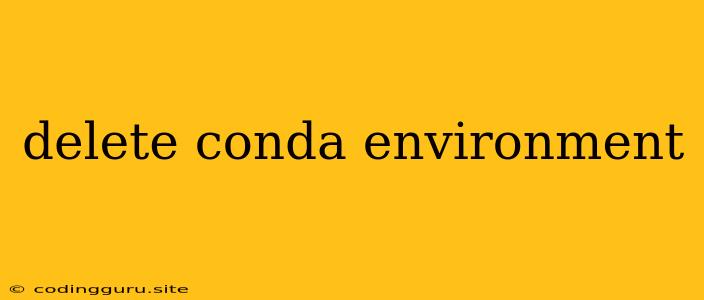How to Delete a Conda Environment?
Conda is a powerful package and environment manager widely used in data science and machine learning. It allows you to create isolated environments for your projects, ensuring that different projects don't interfere with each other's dependencies. Sometimes, however, you might find yourself with a conda environment that you no longer need. In such cases, you'll want to delete the conda environment. This article will guide you through the process of deleting a conda environment using the conda command.
Understanding Conda Environments
Before we delve into the deletion process, let's briefly understand the concept of conda environments. A conda environment is a self-contained directory that holds specific versions of Python, packages, and libraries required for a particular project. When you create a conda environment, you essentially create a separate space where you can install packages without affecting your base environment.
Why Delete a Conda Environment?
There are several reasons why you might want to delete a conda environment:
- Space optimization: If you have multiple environments, some of them may no longer be in use. Deleting these unused environments helps free up disk space.
- Project completion: Once you've completed a project, you may decide to delete the conda environment associated with it to avoid clutter.
- Environment conflicts: Sometimes, you might encounter conflicts between different environments. Deleting a problematic environment can help resolve these conflicts.
Steps to Delete a Conda Environment
Step 1: Activate the environment
Before you can delete an environment, you need to activate it. This ensures that the conda command will operate within the correct environment. Use the following command, replacing "environment_name" with the name of the environment you want to delete:
conda activate environment_name
Step 2: Use the conda remove command
Once you've activated the environment, you can use the conda remove command to delete it. The -n flag specifies the name of the environment you want to remove. Here's the command:
conda remove -n environment_name --all
The --all flag ensures that all packages and dependencies associated with the environment are also removed.
Step 3: Verify the deletion
After executing the conda remove command, you can verify that the environment has been deleted by listing your available environments using the following command:
conda env list
The deleted environment should no longer appear in the list.
Example
Let's say you have a conda environment called "my_project". To delete it, you would follow these steps:
-
Activate the environment:
conda activate my_project -
Use the
conda removecommand:conda remove -n my_project --all -
Verify the deletion:
conda env list
If "my_project" is no longer in the list, the environment has been successfully deleted.
Important Considerations
- Backup your data: Before deleting a conda environment, ensure that you have backed up any important data or project files associated with it.
- Be careful with the base environment: Never use the
conda removecommand on your base environment (usually named "base"). This could lead to unintended consequences. - Alternative methods: There are other ways to delete a conda environment, such as using the
conda env removecommand or the Anaconda Navigator interface.
Conclusion
Deleting a conda environment is a straightforward process that can help you optimize your workspace and manage your projects more effectively. By following the steps outlined in this article, you can easily remove any conda environment that you no longer need, freeing up space and simplifying your workflow. Remember to exercise caution when deleting environments, especially your base environment, and ensure you have backed up any important data.
